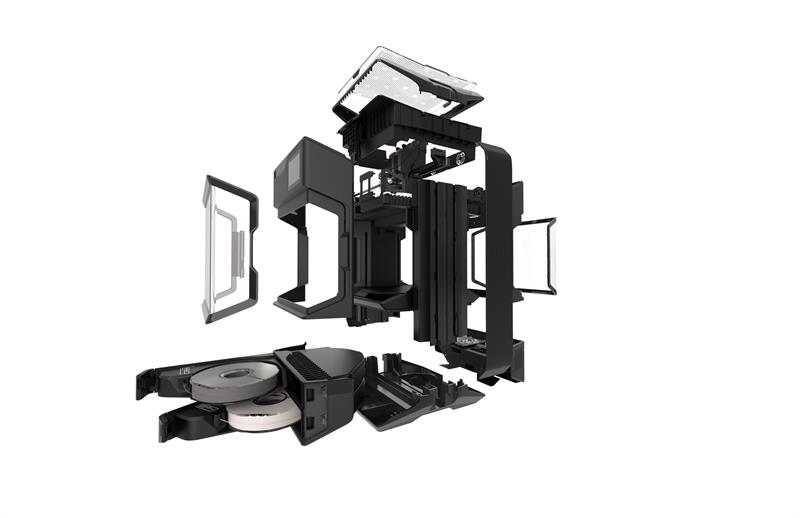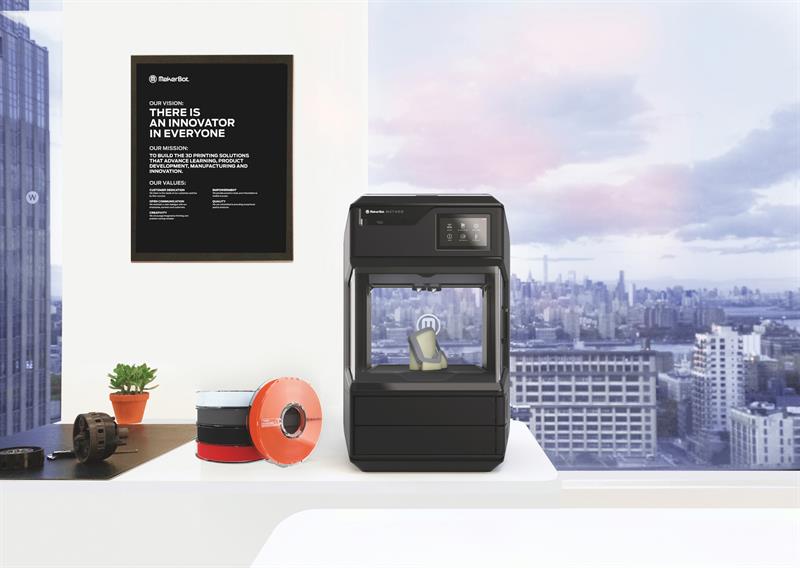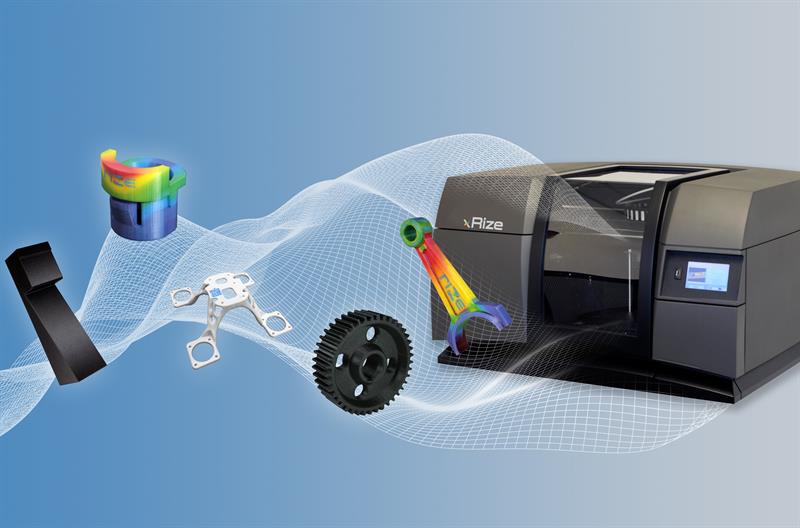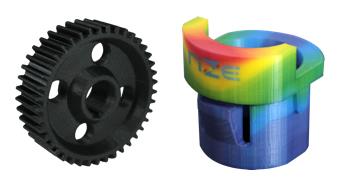While one cannot yet say that process is complete, it is certainly the direction of travel. And, as some of the most recent developments in the field make clear, 3D printing is increasingly becoming a mainstream technology. The dream, however, is an affordable 3D printer that sits on an office desktop and has the capacity to produce high-quality prototypes within a reasonable timeframe and at a reasonable cost.
By achieving this, it is felt, the true advantages of 3D printing will finally become available to all and the possibilities of the technology will be more widely understood. This is why a number of manufacturers have made significant recent strides in this direction.
As a pioneer of desktop 3D printing, it is perhaps no surprise to see that MakerBot is in the vanguard of this movement. Recently, it introduces a new category for the professional segment with the launch of Method, the first so-called ‘performance 3D printer’.
According to vice president of engineering at MakerBot Dave Veisz, ‘Performance 3D Printing’ bridges the gap between desktop and industrial 3D printing by bringing features that were previously only available on industrial 3D printers to professionals at a significantly lower cost.

Method is designed to deliver industrial reliability and precision by carefully controlling every aspect of the 3D print environment, resulting in repeatable and consistent parts with ± 0.2 mm dimensional accuracy as well as vertical layer uniformity and cylindricity. Until now, this level of precision has been limited to industrial-grade 3D printers. The dual extrusion system found in Method combined with water-soluble PVA provides a superior surface finish, and enables unlimited design freedom and unrestricted geometries, such as complex overhangs without scarring.
Nadav Goshen, MakerBot CEO makes the point that until now desktop 3D printers have simply not been able to match the capabilities of their industrial counterparts. He says: “In an age of disruption, businesses are under pressure to innovate and bring products to market faster. Current desktop 3D printers derive their DNA from hobbyist 3D printers and are insufficient for many applications in the professional segment.
“We believe that Method is the next step in helping organisations adopt 3D printing at a larger scale. Method provides a breakthrough in 3D printing that enables industrial designers and mechanical engineers to innovate faster and become more agile. It is built for professionals who need immediate access to a 3D printer that can deliver industrial performance to accelerate their design cycles. Method is developed to bring industrial technologies into an accessible platform, breaking the price-performance barrier and redefining rapid prototyping in the process.”
This is achieved by including a range of features on the new machine that have previously been the preserve of expensive industrial machines. These include a circulating heated chamber that controls the temperature and quality of every layer. In providing full active heat immersion during the entire duration of the print, Method allows printed materials to cool at a controlled rate, providing higher dimensional accuracy while improving layer adhesion and part strength.

Method’s dual performance extruders are built for high-speed printing without compromising part accuracy. A dual-drive gear system grips the material securely while a powerful 19:1 gear ratio provides up to three times the push force of a typical desktop 3D printer. This allows Method to provide a consistent feed of material into the hot end to produce consistent geometry. The new lengthened thermal core is up to 50% longer than a standard desktop hot end to enable faster extrusion rates and allows for smooth extrusion throughout its high-speed movements and accelerations.
Precision PVA dissolvable supports enable fast and easy support removal without compromising part design or dimensional accuracy. Water-soluble PVA provides unrestricted geometric freedom and superior print quality and surface finish without the need for harsh solvents of industrial 3D printers or manual labour of removing breakaway supports.
The machine’s dry-sealed material bays form a seal to keep filament material pristine and reduce moisture absorption. A suite of built-in sensors monitors humidity and alerts users of any changes to the environment—a feature previously only available on industrial 3D printers. This feature is especially crucial for water-soluble PVA, which absorbs moisture when left in the open with devastating consequences on print quality. Meanwhile, the rigid metal frame runs the full length of the Method body to offset flexing. Less flexing means more consistent prints with better part accuracy and fewer failures.
MakerBot offers two categories of materials for use with Method: Precision and Specialty. Precision Materials are extensively tested by MakerBot for the highest reliability and measurably accurate parts and include MakerBot Tough, MakerBot PLA, and MakerBot PVA. Speciality materials are for users looking for materials with advanced properties to push the limits of what’s possible. These materials provide basic print performance and can require additional workflow steps to print successfully. The first material on the platform is PETG, one of the most widely used polymers with excellent engineering properties, with more to follow.
Method delivers industrial-level performance at one-third of the first-year cost of ownership of an entry-level industrial 3D printer. Says Steve Veisz: “With Method, teams can reduce design risks by testing and validating prototypes with accuracy early and often, minimising potential cost overruns later in production. It is also designed to provide an elevated level of speed and control into product design cycles while reducing production costs – helping businesses bring products to market faster.”
Method is ultimately designed to make industrial 3D printing technologies accessible to individual designers and engineers. Advanced workflow features turn Method into an everyday tool that accelerates the agile design process. Users can turn their CAD files to parts faster and print up to two times faster than desktop 3D printers.
Not to be outdone, in what it describes as “a giant leap to deliver flexibility and scalability to customers”, Rize, a Boston, USA-based, next-generation additive manufacturing company, has announced new hardware, materials and IoT functionality in XRize, which it describes as the world’s first true colour desktop industrial 3D printer.
Until now, users had to produce non-functional colour parts or implement very expensive solutions, making trade-offs between colour, strength and price. These trade-offs have limited the expansion of additive manufacturing to users across the enterprise and inhibited true innovation. Moreover, companies had to purchase separate 3D printers to achieve varying capabilities, including office use, full colour, end-use and production parts and the ability to use carbon fibre and other materials.
XRize enables users to manufacture functional polymer and composite parts in full colour. And, since Rize’s intelligent and innovative solutions focus on the user as much as the machine, XRize is easy to use, safe and enables markup to provide much-desired IP security, traceability and branding.

Rize claims that the experience of using the XRize 3D printer is as easy and safe as an office 2D printer. Providing a safe, clean process, minimal pre- and post-processing and minimal material management, it is designed to take users throughout the enterprise, from engineering to marketing to the manufacturing floor. XRize, it is claimed, can easily manufacture full-colour prototypes for FEA and stress analysis, tooling with safety instructions, consumer products, package design, GIS (Geographic Information System) mapping, anatomical parts for patient/clinician communication, pre-surgical planning and parts for marketing and the entertainment industry.

XRize leverages Rize’s patented Augmented Deposition process by extruding an engineering-grade thermoplastic and simultaneously jetting C, M, Y, K (cyan, magenta, yellow and black) inks through industrial printheads to achieve the full-colour part. Release ink is jetted between the part and the automatically-generated supports to enable the user to quickly peel the supports away from the part, leavinga smooth surface finish and eliminating the need for additional finishing. With Rize OneTouch software, users can quickly and easily apply text, images and texture maps to monochrome part files and import colour CAD files.
The RIZE system runs multiple materials, including Rizium One, Rizium Black and the new Rizium Carbon and Rizium Endura materials. Minimal pre- and post-processing provide the fastest time to part, while ease of operation is provided by an auto-levelling build plate, automatic filament changeover and intuitive high-resolution touchscreen for access to part library, build management and system diagnostics.
What is clear from these innovations is that, while the dream of a 3D printer being as commonplace and ubiquitous in the working environment as a 2D printer may not quite be here yet, it is getting closer.





